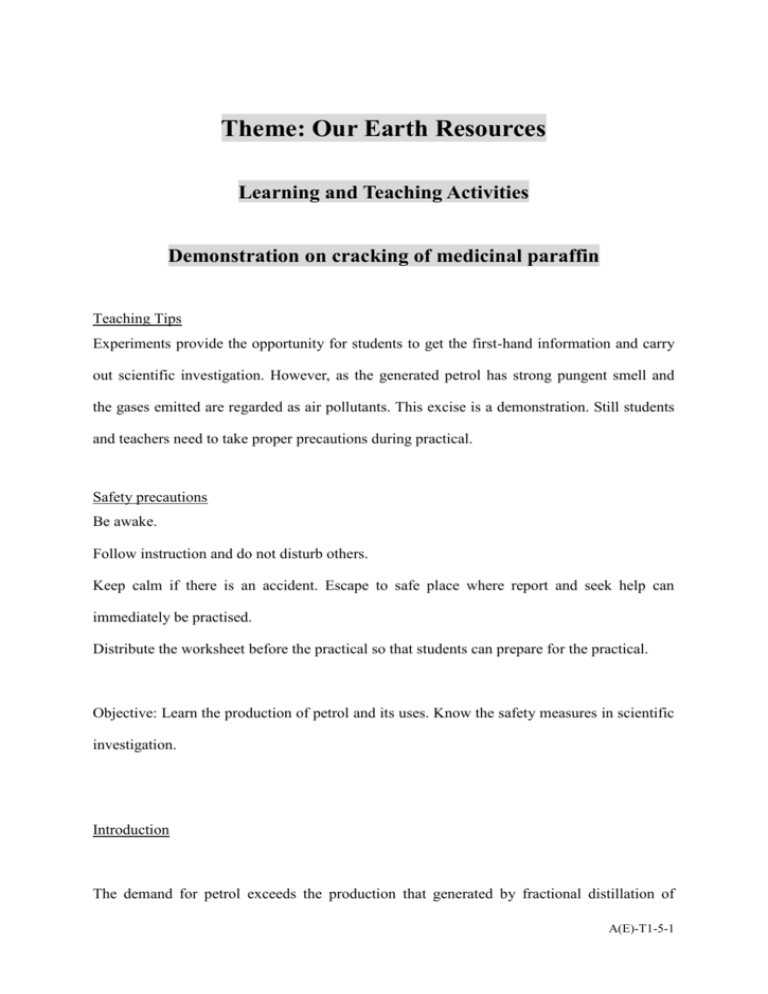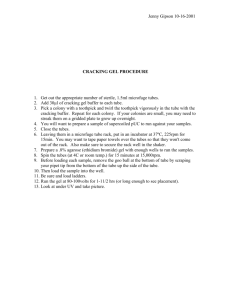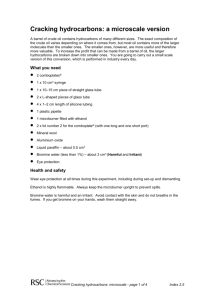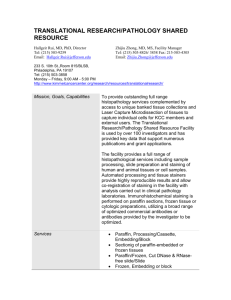pollutants flammability
advertisement

Theme: Our Earth Resources Learning and Teaching Activities Demonstration on cracking of medicinal paraffin Teaching Tips Experiments provide the opportunity for students to get the first-hand information and carry out scientific investigation. However, as the generated petrol has strong pungent smell and the gases emitted are regarded as air pollutants. This excise is a demonstration. Still students and teachers need to take proper precautions during practical. Safety precautions Be awake. Follow instruction and do not disturb others. Keep calm if there is an accident. Escape to safe place where report and seek help can immediately be practised. Distribute the worksheet before the practical so that students can prepare for the practical. Objective: Learn the production of petrol and its uses. Know the safety measures in scientific investigation. Introduction The demand for petrol exceeds the production that generated by fractional distillation of A(E)-T1-5-1 crude oil. Cracking of heavy fractions of petroleum could synthesize petrol to meet the demand of modern world. This experiment is to model the industrial cracking process in a teaching laboratory. Materials Boiling tube Delivery tube Test tube Stopper Bunsen burner Water trough Stand Glass wool Liquid paraffin Porcelain chips Safety Precaution 1. The experiment should be carried out inside a fume hood. 2. Wear eye protection throughout the experiment. 3. Beware of the sucking back in water trough, lift the apparatus out of water using stand when heating stops. 4. Make sure the apparatus especially the delivery tubes are not blocked. 5. Paraffin is inflammable. Procedures 1. Set up the experimental apparatuses as shown in Figure 1. Fill three test tubes with water and invert them in the water trough. A(E)-T1-5-2 glass wool soaked with liquid paraffin Figure 1. Experimental set up of cracking of medicinal paraffin 2. Strongly heat the porcelain chips (catalyst for cracking) by a Bunsen burner for 5 minutes. 3. Heat the glass wool containing liquid paraffin. Try to make a steady stream of gas bubbles. 4. Collect tubes of the gases obtained from cracking; discard the first one. 5. Stopper the remaining two tubes of gases. 6. Examine the smell of the glass collected. Observation Discussion 1. Smell the gases produced by cracking of medicinal paraffin. Describe the smell. A(E)-T1-5-3 2. The first test tube of gases obtained should be discarded. Suggest reason(s) for it. 3. Compare the flammability of the medicinal paraffin with gaseous product. (Hint: Use glowing splint and lighted splint respectively). A(E)-T1-5-4 Suggested answers (Accept alternative and correct answers) 1. Smell the gases produced by cracking of medicinal paraffin. Describe the smell. The smell is similar to that of liquefied petroleum gas. 2. The first test tube of gases obtained should be discarded. Suggest reason(s) for it. It is because the first tube of gases obtained contains the gases in the boiling tube (contain mainly oxygen and nitrogen). 3. Compare the flammability of the medicinal paraffin with the gaseous product. (Hint: Use glowing splint and lighted splint respectively). The medicinal paraffin is not flammable and gives out black smoke in combustion. The gaseous product is flammable, flame color is yellow – blue, and do not gives out black smoke. A(E)-T1-5-5








